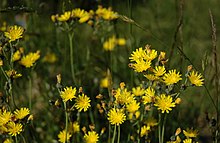
Back باشقية Arabic حشيشة الغراب ARZ Qırğıotu Azerbaijani قیرغی اوْتو AZB Ястрабок Byelorussian Hieraci Catalan Hieracium CEB Jestřábník Czech Heboglys Welsh Høgeurt Danish
| Hieracium | |
|---|---|

| |
| Hieracium caespitosum | |
| Scientific classification | |
| Kingdom: | Plantae |
| Clade: | Tracheophytes |
| Clade: | Angiosperms |
| Clade: | Eudicots |
| Clade: | Asterids |
| Order: | Asterales |
| Family: | Asteraceae |
| Subfamily: | Cichorioideae |
| Tribe: | Cichorieae |
| Subtribe: | Hieraciinae |
| Genus: | Hieracium L. |
| Synonyms | |
Hieracium (/haɪ.əˈræsiəm/),[3] known by the common name hawkweed[4] and classically as hierakion (from ancient Greek ιεράξ, hierax 'hawk'),[5] is a genus of flowering plant in the family Asteraceae, and closely related to dandelion (Taraxacum), chicory (Cichorium), prickly lettuce (Lactuca) and sow thistle (Sonchus),[6] which are part of the tribe Cichorieae. Hawkweeds, with their 10,000+ recorded species and subspecies,[7] do their part to make Asteraceae the second largest family of flowering plants.[8] Some botanists group all these species or subspecies into approximately 800 accepted species,[9] while others prefer to accept several thousand species. Since most hawkweeds reproduce exclusively asexually by means of seeds that are genetically identical to their mother plant (apomixis or agamospermy), clones or populations that consist of genetically identical plants are formed and some botanists (especially in UK, Scandinavia and Russia) prefer to accept these clones as good species (arguing that it is impossible to know how these clones are interrelated) whereas others (mainly in Central Europe and USA) try to group them into a few hundred more broadly defined species. What is here treated as the single genus Hieracium is now treated by most European experts as two different genera, Hieracium and Pilosella, with species such as Hieracium pilosella, Hieracium floribundum and Hieracium aurantiacum referred to the latter genus. Many members of the genus Pilosella reproduce both by stolons (runners like those of strawberries) and by seeds, whereas true Hieracium species reproduce only by seeds. In Pilosella, many individual plants are capable of forming both normal sexual and asexual (apomictic) seeds, whereas individual plants of Hieracium only produce one kind of seeds. Another difference is that all species of Pilosella have leaves with smooth (entire) margins whereas most species of Hieracium have distinctly dentate to deeply cut or divided leaves.
A dry roadside dotted with small, ¾ inch red orange flowers, interspersed with very similar yellow ones, and often the white of daisies, is a good sign that you are in Hawkweed country.
— Marion Edsall[10]
- ^ International Organization for Plant Information (IOPI). "Vascular Plants of Russia and Adjacent Countries as of 26.10.96". Provisional Global Plant Checklist. International Organization for Plant Information (IOPI). Archived from the original on 2013-12-13. Retrieved 2007-12-17.
- ^ Germplasm Resources Information Network. "Genus: Hieracium L." (GRIN) Online Database. USDA, ARS, National Genetic Resources Program. Archived from the original on 2013-12-13. Retrieved 2007-12-23.
- ^ "Guide to the Pronunciation of Specific, Generic and Family Names". Southern California Wildflowers. Archived from the original on 2007-11-02. Retrieved 2007-12-22.
- ^ Natural Resources Conservation Service (2007). "Classification for Kingdom Plantae Down to Genus Hieracium L." The PLANTS Database. USDA, Baton Rouge, LA 70874-4490 USA. Archived from the original on 2019-06-21. Retrieved 2007-12-18.
- ^ Charters, Michael L. "HI-HY". California Plant Names: Latin and Greek Meanings and Derivations A Dictionary of Botanical Etymology. Archived from the original on 2016-04-16. Retrieved 2007-12-26.
- ^ Cooperative extension service, Matthew J. Rinella and Roger L. Sheley (December 2002). "Orange and Meadow Hawkweed, 199816". MontGuide fact sheet (Reprint ed.). Department of Land Resources and Environmental Sciences, Montana State University - Bozeman. Archived from the original on 2007-08-14. Retrieved 2007-12-22.
- ^ International Organization for Plant Information (IOPI). "Plant Name Search Results". International Plant Names Index. Archived from the original on 2012-10-10. Retrieved 2007-12-17.
- ^ Niehaus, Theodore F. (1976). Pacific States Wildflowers. Peterson Field Guides. Illustrations by Charles L. Ripper. New York: Houghton Mifflin Company. pp. 102, 220. ISBN 0-395-91095-1.
- ^ International Organization for Plant Information (IOPI). "Details for: Hieracium". Provisional Global Plant Checklist. Archived from the original on 2013-12-13. Retrieved 2007-12-17.
- ^
Edsall, Marion (2007-12-15) [1985]. Roadside Plants and Flowers A Traveler's Guide to the Midwest and Great Lakes Area. Cover design: Bruce Gore. Madison, Wisconsin: University of Wisconsin Press. pp. 46. ISBN 978-0-299-09704-2. Dewey 582.0977.
A dry roadside dotted with small, 3/4 inch red orange flowers, interspersed with very similar yellow ones, and often the white of daisies, is a good sign that you are in Hawkweed country.
© MMXXIII Rich X Search. We shall prevail. All rights reserved. Rich X Search